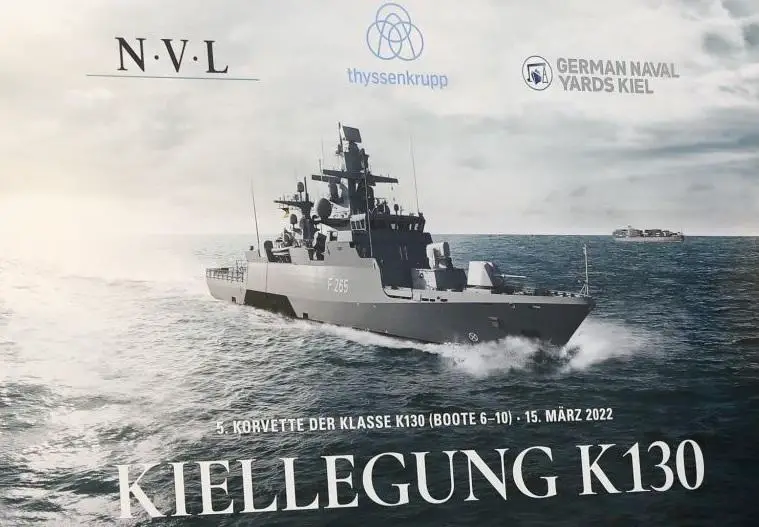Naval Vessels Lurssen (NVL) Group has announced the keel laying of the final Class 130 (Korvette 130, Braunschweig class) corvette for the German Navy, indicating the platform production of the five new ships is in its final stages. Five ships have replaced the Gepard-class fast attack craft of the German Navy. The Class 130 corvettes are Germany’s newest class of ocean-going corvettes. The new corvettes are manufactured under the leadership of NVL Group, formerly Lürssen Defence, by the K130 consortium, consisting of NVL Group, thyssenkrupp Marine Systems and German Naval Yards Kiel. Parallel to the keel laying of the stern, the last foredeck was put in place at the Kiel shipyard of German Naval Yards. The foredeck and avert ships are to be moved to Hamburg for the merger.
In October 2016 it was announced that a second batch of five more corvettes is to be procured from 2022–25. The decision was in response to NATO requirements expecting Germany to provide a total of four corvettes at the highest readiness level for littoral operations by 2018, and with only five corvettes just two can be provided. Traditionally, in the German Navy, this was used as a rule to classify a vessel as a boat, not a ship. In a press release, the German Navy stated that these corvettes will be called ships nonetheless because of their size, armament, and endurance. However, in size, armament, protection, and role, these corvettes resemble modern antisurface warfare light frigates, the main difference being the total absence of any antisubmarine warfare related sensors or weapons.

The K130 Corvettes have been designed with stealth features, low draft and automated weapon and defence systems to support littoral warfare. They feature reduced radar and infrared signatures (“stealth” beyond the Sachsen-class frigates) and will be equipped with two helicopter UAVs for remote sensing. Recently, the German Navy ordered a first batch of two UMS Skeldar V-200 systems for the use on the Braunschweig-class corvettes. The hangar is too small for standard helicopters, but the pad is large enough for Sea Kings, Lynx, or NH-90s, the helicopters of the German Navy. The German Navy has ordered the RBS-15 Mk4 in advance, which will be a future development of the Mk3 with increased range —400 km (250 mi)— and a dual seeker for increased resistance to electronic countermeasures. The RBS-15 Mk3 has the capability to engage land targets.
Lurssen (or Lurssen Werft) is a German shipyard with headquarters in Bremen-Vegesack and shipbuilding facilities in Lemwerder, Berne and Bremen-Fähr-Lobbendorf. the Lurssen Group continues to operate its naval shipbuilding business under the new umbrella brand NVL (Naval Vessels Lurssen). Formerly known as Lurssen Defence, NVL Group builds and repairs all classes of high-quality naval vessels for the German Navy and other navies worldwide. The brand name is new, but the core values remain the same – trust, reliability and quality are just as much a part of NVL Group as they were Lurssen Defence. With four Northern German shipyards for newbuilds, repairs and more, NVL Group owns the facilities to build and support ships from 20m to 200m using the most advanced shipbuilding technology. Lurssen is currently also involved with the building of Braunschweig-class corvettes and is part of the ARGE F125 joint-venture designing the Baden-Württemberg-class frigates. Lürssen also has the contract to design and build twelve Arafura-class offshore patrol vessels for Australia.















